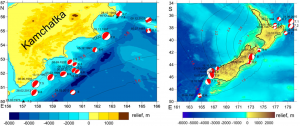During last decades, the question of the effect of ocean tides on seismicity has been widely investigated. The issue of whether tidal forces really affect seismicity has been raised many times in the literature.
In the present study the differential probability gain approach (Shebalin et al., 2012; Shebalin et al., 2014) is used to estimate quantitatively the change in aftershock rate at various levels of ocean tides, relative to an average Omori-Utsu model that supposes no dependence on tides. The differential probability gain function is a numeric factor indicating how much the rate of aftershocks is increased or decreased on average at specific values of the tide heights.
The authors of the article chose to analyze aftershock sequences of large (M ≥6) earthquakes off Kamchatka, 1971–2013 (16 sequences) and New Zealand, 1979–2016 (15 sequences).

The observed increase in the rate of aftershocks at high and/or low water demonstrated a significant effect of ocean tides on seismicity. One important feature that distinguishes this study from most others is that we studied the heights rather than the phases of ocean tides. Moreover, the goal of this study was to find quantitative estimates of the increase in seismicity rate at specific heights of the ocean tides. For normal fault earthquakes the effect is stronger at low water, for thrust events mostly at high water, and for strike-slip earthquakes at high and/or low water.
Although the differential probability gains function shape may vary from one sequence to another, the scientists observed a clear tendency of increasing aftershock rate by about two times at either low or high water. As an explanation of this effect, the authors can suggest friction reduction on a fault due to vertical stress decreasing at low waters and due to increased pore pressure at high waters. For normal faults an increase in aftershock rate was observed at low water, and thus the friction reduction mechanism due to the unloading of vertical stress is more likely. For thrust earthquakes, an increase in aftershock rate was observed at high water, and in that case increased pore pressure is the preferable mechanism. For strike-slip events with intermediate stresses both mechanisms can operate.
The main practical result of this study is a quantitative assessment of the effect of ocean tides on earthquake rate. Although the results were obtained for aftershocks, the authors may suppose that similar dependences are valid for all seismic events.
Source: Shebalin P.N., Baranov A.A. Aftershock Rate Changes at Different Ocean Tide Heights // Frontiers in Earth Science. 2020. V. 8. Article 559624. DOI:10.3389/feart.2020.559624

